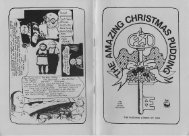You also want an ePaper? Increase the reach of your titles
YUMPU automatically turns print PDFs into web optimized ePapers that Google loves.
JAPAN<br />
For many (but not all) collectors the Japanese CDs are<br />
very collectible. On the other hand, the number of<br />
Japanese issues is not overwhelming and <strong>com</strong>pleting a<br />
collection is easier than collecting the European issues.<br />
The Japanese CDs are generally a little bit expensive but<br />
only a few of them are really extortionatingly priced. Above<br />
all in Europe the Japanese CDs are very highly valuated,<br />
but maybe only because they are exotic items.<br />
There are several differences between the Japanese<br />
editions and the editions from the rest of the world. Many<br />
Japanese CDs includes an additional insert with Japanese<br />
text (track listing, a brief history of the band etc). The CDs<br />
without these inserts have additional pages in the regular<br />
booklet with a similar text. Typically is also an obi, a piece<br />
of a paper strip wrapped around the case or a special<br />
sticker on many cardboard editions. Many of the Japanese<br />
jewel cases, especially the older ones, are a little different<br />
from the European and US cases. They have a contraption<br />
in the form of a triangle at the innermost corners of the lid.<br />
The purpose is to support the booklet in addition to the<br />
usual holders. And the trays are frequently bright or white.<br />
A Japanese CD is considered to be in<strong>com</strong>plete without the<br />
obi, sticker (if originally supplied) and Japanese insert (if<br />
originally supplied) and its value decreases.<br />
In Japan, Pink Floyd's CD editions did go through some<br />
major phases (but they did overlap for some time): EMI,<br />
SONY and Toshiba. A typical print run have always been<br />
limited to 2000-5000 copies for each issue.<br />
Sony Records opened the first <strong>com</strong>mercial <strong>com</strong>pact disc<br />
pressing plant in April 1982 in Shizuoka Prefecture, Japan.<br />
The <strong>com</strong>pact disc was launched in Japan on October 1,<br />
1982. All the early Pink Floyd CDs released in Japan were<br />
pressed by Sony, including some titles made by Sony for<br />
Toshiba-EMI Records.<br />
Toshiba-EMI Records began manufacturing their own Pink<br />
Floyd <strong>com</strong>pact discs in Japan in 1986. In December 2005,<br />
Toshiba-EMI sold the CD pressing plant in Gotemba to<br />
Memory Tech Corporation, who then took over the<br />
manufacturing of CDs for EMI in Japan. The partnership<br />
between Toshiba and EMI ceased in the summer of 2007<br />
when Britain's EMI Group purchased Toshiba's share of<br />
Toshiba-EMI Limited.<br />
The very first Japanese Pink Floyd CD was the album Wish<br />
You Were Here issued on EMI (35DP 4), pressed by CBS /<br />
Sony Records and released in October 1982.<br />
EMI Japan<br />
EMI released some of the very first Pink Floyd issues.<br />
Between 1986 and 1989 EMI released the albums from<br />
The Piper at the Gates of Dawn to The Dark Side of the Moon<br />
included and Syd Barret's Opel.<br />
Two different editions of these Pink Floyd EMI albums<br />
exist, the original and the reprint, which are pretty much<br />
the same. The catalogue numbers on both versions are<br />
identical. But the original price, printed on the first editions<br />
on the rear cover, last page of the booklet and on obi, was<br />
on the reprint only printed on the obi (with changed<br />
amount). On some reprints the original price was simply<br />
overprinted. On some others reprints the price was simply<br />
not printed on artwork.<br />
Obis from More: Left the first issue, right the reprint<br />
Rear artwork of The Dark Side of the Moon:<br />
left original with printed price, right the reprint without price.<br />
The catalogue numbers appears as CPxx-yyyy.zz, where<br />
xx is the price class and yyyy is the catalogue number. The<br />
optional zz code is found in case of double (or triple by<br />
other artists) editions, to show the last digits of the<br />
catalogue number from the second (or triple) CD.<br />
In 2006 and 2007 EMI released two series with reissues of<br />
many remastered Pink Floyd albums.<br />
Rear artwork of Atom Heart Mother with the logos of the series on obi.<br />
Left ‘ROCK UK’, right ‘EMI 100’. The text under the barcode is different.<br />
The 2007 catalogue numbers are the same as the 2006<br />
numbers. Very few differences between the 2006 and the<br />
2007 issues are visible at the rear of the obi. The names of<br />
the series are printed on rear top of obi. The 2006 reissues<br />
have on top a red rectangle with “ROCK UK” and the 2007<br />
issues have a gold rectangle with “EMI 100”. Another<br />
visible difference is the different Japanese text under the<br />
barcode. The Japanese text on the obi listed a different<br />
URL. The number 1 in the yellow field on the front of the<br />
obi indicates that the sales period is limited to one month.<br />
Furthermore one can notice that the English and Japanese<br />
inscriptions on the rear covers are arranged differently.<br />
Beside the differences on artwork, the Japanese insert<br />
from the “ROCK UK” series has the The Piper at the Gates of<br />
Dawn listed, whilst the insert from “EMI 100” omit this.






